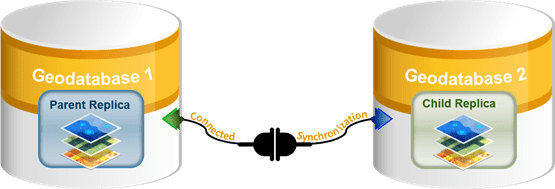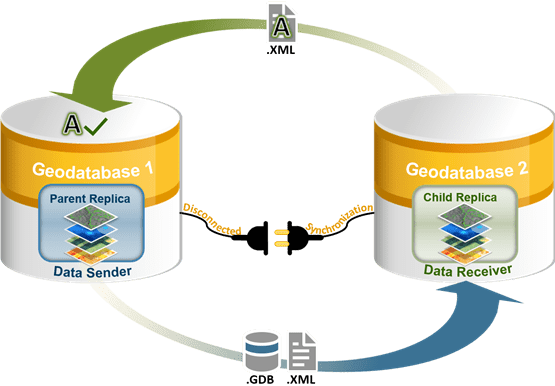Available with Standard or Advanced license.
Synchronization involves one replica sending data changes and the relative replica receiving changes. Data changes include inserts, updates, and deletes made in the replica version. To perform a synchronization, you must be connected as the same database user that was used to create the replica, or you must be the geodatabase administrator.
For two-way and one-way replication, the filters and relationship class rules that were applied at creation are also applied to determine what changes to synchronize. Changes outside the filters and relationship class rules are not synchronized. See Replication and related data to learn how to find the filters and relationship class rules for a replica. Logic is also used to prevent unnecessarily resending changes that have already been sent. For checkout replicas, all edits made to the checkout replica are synchronized.
Data transfers during synchronization consists of exchanging multiple replication messages that include sending and receiving data and acknowledgement messages between the replica pair. Message exchange between replicas is designed to be sequential. This means that the replicas are set up to exchange messages in a manner similar to the way voice messages are exchanged between parties engaged in a telephone conversation: each party sends a message to the other that is received and processed before the other party responds. The nature of the system ensures that only one replica can send changes at a time.
Synchronization is supported in both a connected and a disconnected environment. In a connected environment, message exchange is managed by the system, while in a disconnected environment, you need to manage the message exchange.
During synchronization, changes are reconciled and posted to the replica version. During this reconcile, conflicts can occur. You can choose a reconcile policy to define how to manage these conflicts. You can also choose between column-level and row-level conflict detection for this reconcile.
Note:
Metadata for the data you choose to replicate is copied during the replica creation process. However, changes to the metadata are not applied during replica synchronization.
Connected synchronization

For replicas in a connected environment you connect to the replica geodatabases directly and choose the replica to synchronize. All the required message exchanges needed to complete a synchronization are executed and managed by the system. You never have to be concerned with message exchange or which replica is the sender or receiver.
For more information on connected synchronization, see A quick tour of replica synchronization.
Disconnected synchronization

In a disconnected environment, while you can perform the same replication procedures that you can accomplish while in a connected environment, the difference is to transfer data you need to manually exchange data-change and acknowledgement messages between the replica pair. This manual process of exchanging messages between replica pairs is known as disconnected synchronization.
For more information, see Disconnected synchronization.